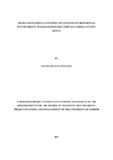| dc.contributor.author | Mwangi, David N | |
| dc.date.accessioned | 2017-12-14T06:40:32Z | |
| dc.date.available | 2017-12-14T06:40:32Z | |
| dc.date.issued | 2017 | |
| dc.identifier.uri | http://hdl.handle.net/11295/101877 | |
| dc.description.abstract | Dadaab sub-County of Garissa has undergone unprecedented transformation over the last
three decades. There are sprawling human settlements in the Dadaab Refugee camps. These
settlements, and their resultant activities have had attendant impact on the socio-cultural,
biological and physical environment. The indiscriminate felling of trees and vegetation cover
to meet the never ending demand for shelter and fuelwood is materially worrying. Daylong
foraging for brush and pastures has led to protracted conflicts between the host and refugee
pastoralist. Sand harvesting to build mud walls have left gaping craters on the once
aesthetically appealing landmass. Garbage generation and disposal has been a daunting task
to the local environmentalist. It is an eyesore in the camps and in Dadaab town with nonbiodegradable
waste strewn everywhere. Abstraction of ground water resources through
boreholes has depleted the aquifer. The purpose of this project therefore was to investigate
and quantify the influence of this human settlement activities in Dadaab Refugee Complex on
the environmental sustainability under the following objectives: establish the influence of
competition for natural resources on environmental sustainability; assess the influence of
economic activities on environmental sustainability; determine the influence of conflict
management on environmental sustainability; examine the influence of access to social
amenities on environmental sustainability; establish the influence of environmental
regulatory framework on environmental sustainability. The project has reviewed the existing
literature on these human settlement and has identified a knowledge gap to be addressed
through survey research design. The target population for this project are the UN agencies,
affiliated NGOs, local and National government, host community and refugees. In the case of
host and refugees, random sampling will be used. This project will use mixed method i.e.
qualitative and quantitative research method. Questionnaires, key informant Interviews and
observations shall be used as data collection tools.Quantitative data will be entered and coded
into Statistical Packages for Social Sciences (SPSS) and analyzed using descriptive statistics.
The findings of this study was that human settlement activities have influenced
environmental sustainability. Competition for natural resources has decreased vegetation
cover, contamination of water sources and led to air pollution due to clouds of air from the
bare land. Economic activities have increased non-biodegradable waste. This poorly disposed
waste have influenced soil fertility and aeration. The same economic activities have led to
soil erosion due to sand harvesting. Conflicts management with uncontrolled livestock herds
has resulted in soil compaction and loss of indigenous plant species. Access to social
amenities have increased the burden of construction materials which are harvested from the
immediate environment. Environmental regulatory agencies have labored to restore the
environment to its original glory. This study concludes that these activities have adverse
influence on the environment and all the stakeholders need to put in place deliberate efforts to
conserve, restore and rehabilitate the environment. It further recommends that individuals use
the resources bequeathed by the environment responsibly | en_US |
| dc.language.iso | en | en_US |
| dc.publisher | University of Nairobi | en_US |
| dc.rights | Attribution-NonCommercial-NoDerivs 3.0 United States | * |
| dc.rights.uri | http://creativecommons.org/licenses/by-nc-nd/3.0/us/ | * |
| dc.subject | Human Settlement Activities Influencing Environmental Sustainability | en_US |
| dc.title | Human Settlement Activities Influencing Environmental Sustainability in Dadaab Refugee Complex, Garissa County, Kenya | en_US |
| dc.type | Thesis | en_US |



